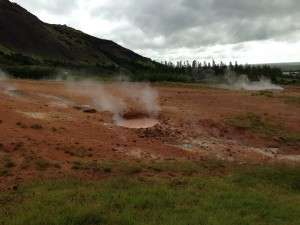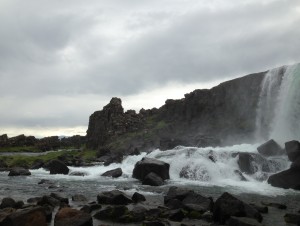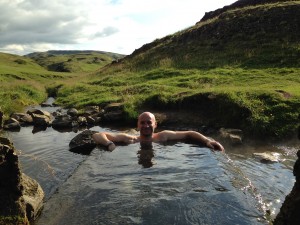We woke up on the second day of our short trip to glorious Icelandic sunshine.
Checking out of the hotel, we wandered across the road to visited the geysers Strokkur and Geysir.
The English word Geyser actually comes from Geysir; this geyser only erupts infrequently and can often stop for years, but when
it does can spray water up to 70 meters high.
We’d been told that Strokkur would erupt every 8 minutes. In reality though, this can vary.
Walking towards the geysir, we saw it erupt in the distance but weren’t quick enough to take a snap. Not expecting it to fire
again for 8 minutes, we were unprepared when it erupted quickly twice more.
When we arrived we took up camera positions opposite the steaming hole and waited.
You could feel the tension in the air. Tourists lined up with cameras at the ready, trying to get the perfect spot. A group of British teenage girls babbled inanities behind me.
10 minutes later, she still hadn’t blown.
There were complaints of “my arm is aching” and “I’ve been waiting here years now” from behind.
Clouds of steam and the smell of sulphur wafted past us. My poor joke of “ah, the eggs are ready” went unappreciated by my girlfriend.
Then a chorus from the rear of the popular childhood song “Why are we waiting“.
Suddenly Strokkur bubbled loudly, and a burst of water spurted anti climatically a few feet into the air and subsided.
There were groans of disappointment from the dejected schoolgirls.
However, the next eruption, approximately 9 minutes later, was spectacular.

There was no warning either. Strokkur shot water 10 meters (33 feet) into the air, soaking those that had stood too close with water, amid screams of surprise and joy.
I’d managed to snap a couple of satisfactory shots and time was ticking, so we headed off on the short (10 mins or so) drive to
the waterfall at Selfoss.

The waterfall is actually a series of waterfalls, Selfoss itself being 11m high, before joining Dettifoss which is apparently the most powerful waterfall in Europe; the river falls 44m over a width of 100m.
The waters are formed by the melting glacier Vatnajökull.
For the first time on our visit, we saw ice – the Langjökull glacier could be just seen in the distance.
We now had a long drive ahead of us. One of the more spectacular sites in south Iceland is the ice lagoon at Jökulsárlón and we
were determined to see it, despite the 4 hour predicted drive.
The maximum speed limit in Iceland is 90kmph, and although we had noted roadside police and speed cameras on the outskirts of the
capital Reykjavik, we hadn’t seen any since (despite a few speed camera signs on the main road ‘1’ from Selfoss towards Vik and
Jökulsárlón there weren’t any devices apparent) and most people seemed to be driving at around 120kmph (75mph). Although the 1 is
a single carriageway (aside from a few overtaking areas on hills) it is very smooth and in good condition (apart from a few spots
where the sides were gradually starting to crumble away into gravel) and with very little traffic on it – we only saw one lorry
in the whole two days, and a couple of tractors – we made good progress.
Petrol stations are few are far between in Iceland, so seeing that we had only half a tank left and spotting a self service (pay
by card at machine) pump just after joining the ‘1’ after leaving the ’30’, we decided to top up our little Hyundai i20 hire car
(hired with our usual cashback by making use of the TopCashBack site).
Just a note here – roads marked ‘F’ are for off road vehicles only. 4×4 / SUVs can be expensive to hire and as we were only there
for the weekend we had opted for a standard car and to avoid these roads. Nonetheless, cutting across country from Gulfoss to
Flúðir had entailed driving down some more basic gravel roads. The car hadn’t struggled at all but we’d been wary of flying gravel. Our hire car was in good shape but had a few paint chips already on the bumper and the damage report on check out had marked these along with a side note ‘gravel damage on bumper’, but just be careful with this as they can be quite strict and it’s easy to damage a vehicle with all that loose gravel, especially if another car comes whizzing by at high speed.
We had intended breaking up the long drive by stopping at the waterfall at Seljalandsfoss and locating the hot springs just
beyond at Seljavallalaug, near Skógafoss.
However, we’d woken later than planned and stayed longer waiting for Strokkur’s eruption; so we only stopped to take a few quick
snaps of the waterfalls at Seljalandsfoss and Skógafoss and not seeing any clear signs to the thermal pool at Seljavallalaug, we
sped onwards, taking in the ever changing scenery and passing Eyjafjallajökull, the volcano that had erupted in 2010 causing
travel chaos due to it’s ash clouds.
One moment we’d see rolling green fields and hills; the next it would be completely flat black earth. After half an hour it would
suddenly change to rounded boulders covered with moss and lichen; it reminded me of the trolls from Disney’s Frozen.
Perhaps this is were the fabled elves lived!
Apparently, more than half of the Icelandic people believe in the existence or possible existence of ‘the hidden people’ –
Huldufolk. There’s an interesting article on the BBC news site here about them.
The scenery changed endless times and we admired the great open spaces, pretty farm houses and numerous waterfalls, rivers and
lakes as we passed by.
We saw the glacier’s of Tindfjallajökull and Eyjafjallajökull nestling amongst the mountains to our right.

Before we got to the town of Vik, about 2.5 hours from Geysir or Reykjavik, we took the side road to Dyrhólaey to visit the
beautiful black sand beach and to look for Puffins. Unfortunately we didn’t see any, probably due to the fact that many other
tourists had decided to do the same and the spot was crowded with humanity. The lovely scenery however had been worth the detour.
We set off again and continued our long trek, now being able to glimpse the huge glacier of Vatnajökull in this distance.
Despite the magnificent backdrop, we were becoming tired and started to worry about how late it was and the fact that we had an
even longer journey back home to the airport.
We followed the endless snake of tarmac through the increasingly barren landscape, passing close to the glacier and staring in
awe at it’s majesty.
We drove on and passed black fields of lava boulders.
As we passed a small car park to our left, we glanced through the black rocks and saw a shining vista of white and blue ice.
We had arrived at the ice lagoon!

Pulling up initially at a car park on the right hand side before the bridge over the Jökulsárlón river, we pulled our aching
bodies from the car and wandering down onto the beach to watch two cow sized chunks of diamond blue ice float by on the breeze. Smaller chunks of clear ice sat on the black sands being lapped gently by the tide.
We then crossed the road and climbed the rocks to see the spectacular ice lagoon below us.

It’s hard to describe the beauty of the various shades of blue and white ice lying in the lagoon, smaller chunks floating serenely
by. I’d let the pictures do the talking but they simply don’t do the atmosphere and beauty of the place justice.

We stayed for some time, walking around and taking photos, but for the first time in our two days in Iceland, we were cold.
We crossed the bridge to the main car park and pulled up next to a small restaurant offering hot soup and coffee. We both went for
the seafood soup (the mushroom option didn’t look very inspiring) which was very tasty and warmed us up beautifully for the drive
back home.
Short on time but determined to at least locate the third hot spring we’d intended to visit, Seljavallalaug, I scoured the road
signs on the drive home around Skógafoss looking for the alleged dirt road towards ‘Seljavellir’.
No such sign exists and as the weather had deteriorated and the going was a little slower, decided to continue towards the airport.
However, for those wanting to visit, I have since located the site via google maps. You will go past a large U shape mountain
enclosure around a handful of buildings in the distance; turn up the 242 sign posted Raufarfell. Hotel Lambafell and guesthouse
Edinborg are also up this road. Carry straight on rather than turning right at the 242 Raufarfellsvegur sign and drive to the end
of the road. The pool is a short walk from there.
Seljavallalaug is a man made geothermal pool, fed by a natural hot spring. It was constructed in 1923 and is a 25 by 10 meter
construction in the mountainside. There are small rooms for people to leave their clothes in. The water however is apparently
only cleaned once every summer so it may look a bit dirty.
We were happy we’d managed to spend so much time at the hot spring of Hrunalaug so didn’t mind missing this one so much. We got
back to the airport bang on time.
One thing we’d missed off the typical tourist sites was the blue lagoon. I wouldn’t go as far as calling this a ‘tourist trap’
but it isn’t cheap and isn’t so natural. However, it does look rather nice and with more time could be tempted to make the most
of it with one of the more inclusive packages.
We would definitely visit again. Next time though we will stay for longer and hire a 4×4; I will also study the maps closer to
ensure we don’t miss anything!!
You can buy the Lonely Planet Iceland (Travel Guide) from Amazon.


